|
Sabena
The Societé anonyme belge d'Exploitation de la Navigation aérienne (French; lit. 'Belgian Corporation for the Exploitation of Aerial Navigation'), better known by the acronym Sabena or SABENA, was the national airline and flag carrier of Belgium from 1923 to 2001, with its base at Brussels Airport. After its bankruptcy in 2001, SN Brussels Airlines was formed through a takeover of former subsidiary Delta Air Transport and took over part of Sabena's assets in February 2002. SN Brussels Airlines merged with Virgin Express in 2007 to form Brussels Airlines. The airline's corporate headquarters were located in the Sabena House on the grounds of Brussels Airport in Zaventem.[1] History1923–1939: Beginnings Sabena began operations on 23 May 1923 as the national carrier of Belgium.[2] The airline was created by the Belgian Government with help of the Devriendt Family after its predecessor SNETA (Syndicat national pour l'étude des transports aériens, National Syndicate for the Study of Aerial Transports) - formed in 1919 to pioneer commercial aviation in Belgium - ceased operations. Sabena operated its first commercial flight from Haren Brussels to London (England) on 1 July 1923, via Ostend. Services to Rotterdam (Netherlands) and Strasbourg (France) were launched on 1 April 1924. The Strasbourg service was extended to Basel (Switzerland) on 10 June 1924. Amsterdam (Netherlands) was added on 1 September 1924, and Hamburg (Germany) followed on 1 May 1929 via Antwerp, Düsseldorf and Essen. Belgian Congo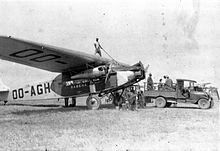 When Sabena was created, the airline was partly funded by Belgians in the Belgian Congo colony who had lost their air service, an experimental passenger and cargo company (LARA) between Léopoldville, Lisala, and Stanleyville a year earlier. They expected the new Belgian national airline to fill this gap. On 12 February 1925, Sabena aviators Edmond Thieffry, Léopold Roger and Joseph De Brycker succeeded in the feat of flying their Handley Page W8 F biplane from Brussels, capital of Belgium, to Léopoldville (now Kinshasa), capital of the Belgian Congo, pioneering a long haul route for passengers traveling between Europe and Africa, and King Albert's daughter, Princess Marie-José flew the route on April 3.[3] Throughout its history, Sabena had a long tradition of service to African destinations and for a long time, these were the only profitable routes served by the airline. Sabena used land planes for its Congo operations and a program of aerodrome construction was initiated in the Congo. This was finished in 1926 and Sabena immediately began flights within the Belgian colony, the main route being Boma-Léopoldville-Élisabethville, a 2,288 km (1,422 mi) route over dense jungle. First, flights were operated with De Havilland DH.50s, although these were quickly replaced by the larger Handley Page W.8f which had three engines and offered ten seats. By 1931 Sabena's fleet, including the aircraft used on the Congo network, totalled 43 aircraft. Its mainstay type was the Fokker F.VIIB with a lesser number of smaller Fokker VIIA and 14 Handley-Page types. It also flew British Westland Wessex aircraft. Sabena occasionally flew to tropical Africa, Belgium's Congo colony, but mostly these aircraft were shipped out. There was no direct flight yet between Belgium and the colony. As the 1930s progressed, Sabena cooperated with Air France and Deutsche Luft Hansa, which also had interests in routes to destinations across Africa. Sabena's first long-haul flight to the Congo occurred on 12 February 1935 and took five and a half days, for which Sabena used a Fokker F-VII/3m aircraft. The following year, Sabena purchased the Savoia-Marchetti SM.73 airliner. With a speed of 300 km/h (200 mph), it reduced the journey time to only four days, and the Sabena service ran on alternate weeks to an Air Afrique service.[citation needed] 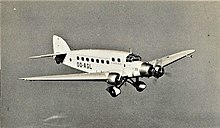 Expansion in EuropeIn Europe, Sabena opened services to Copenhagen and Malmö in 1931 and a route to Berlin was initiated in 1932. The mainstay pre-war airliner that Sabena used in Europe was the successful Junkers Ju 52/3m airliner. The airline's pre-war routes covered almost 6,000 km within Europe. While the Brussels Haren Airport was Sabena's main base, the company also operated services from other Belgian airports and had a domestic network that was mainly used by businessmen who wanted to be in their coastal villas for the weekend. In 1938, the airline purchased the new Savoia-Marchetti SM.83, a development of the S.M. 73 with a speed of 435 km/h (270 mph), although it flew services at a cruising speed of about 400 km/h (250 mph). 1939–1946: WartimeAt the outbreak of World War II in 1939, Sabena's fleet totalled 18 aircraft. Its mainstay fleet type was the Savoia-Marchetti SM.73 airliner (it had 11 of the type) and the Junkers Ju 52/3m airliner (it had five). Sabena also had just taken delivery of two Douglas DC-3s. During the war, the airline maintained its Belgian Congo routes, but all European services ceased. 1946–1960: Transatlantic expansion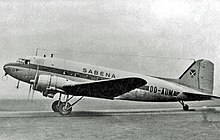 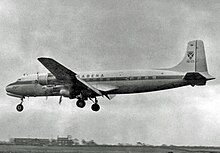 After the war, in 1946 Sabena resumed operating a network of intra-European scheduled services. The fleet initially consisted mainly of Douglas DC-3s. There were thousands of surplus Douglas C-47 Skytrains (the military variant of the DC-3) available to help airlines restart operations after the war. The airline now flew under the name of SABENA - Belgian World Airlines. Sabena started its first transatlantic route to New York City on 4 June 1946, initially using unpressurised Douglas DC-4 airliners which were augmented and later replaced by Douglas DC-6Bs. The DC-4s also restarted the airline's traditional route to the Belgian Congo. Sabena was the first airline to introduce transatlantic schedules from the north of England, when one of its DC-6Bs inaugurated the Brussels-Manchester-New York route on 28 October 1953. The Convair 240 was introduced in 1949 to partially replace the DC-3s that until then had flown most European services. As of 1956, improved Convair 440 "Metropolitan" twins began replacing the Convair 240 twins and were used successfully well into the 1960s between European regional destinations. In 1957, the long-range Douglas DC-7C was introduced for long-haul routes but this plane would begin to be supplanted after only three years by the jet age. It remained in service on the transatlantic route until 1962. On 3 June 1954, a Soviet Air Force Mikoyan-Gurevich MiG-15 (NATO reporting name "Fagot") attacked a Sabena-operated Douglas DC-3 on a cargo flight from the United Kingdom to Yugoslavia, killing the radio operator and wounding both the captain and engineer. Co-pilot Douglas Wilson managed to land in Austria but the plane suffered significant damage.[4] For the 1958 world exposition in Brussels, Sabena leased two Lockheed Super Constellations from Seaboard World Airlines, using them mainly on transatlantic routes. In the same period, there were experiments with helicopter passenger service using Sikorsky S-58 aircraft from Brussels to Antwerp, Rotterdam, Eindhoven and the Paris heliport at Issy-les-Moulineaux. 1960–1990: The jet age
Source: ICAO Digest of Statistics for 1950-55, IATA World Air Transport Statistics 1960-2000
     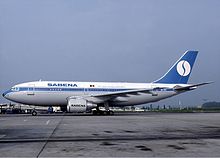  1960 saw the introduction of the Boeing 707-320 intercontinental jet for trans-Atlantic flights to New York. SABENA was mainland Europe's first airline to operate a jet across the Atlantic (BOAC had been flying jet transatlantic services using the de Havilland Comet 4 since 4 October 1958). One of Sabena's aircraft became the first Boeing 707 to crash while in commercial service when Flight 548 crashed while preparing to land at the Brussels Airport on 15 February 1961. The United States Figure Skating Team was aboard the aircraft, en route from New York to Prague via Brussels to compete in a figure skating championship. Six Caravelle jetliners were introduced on all medium-haul routes in Europe from February 1961, being flown on most routes alongside the Convair 440s, until the early 1970s. The beginning of the 1960s saw a major upheaval for Sabena in the Congo. Widespread rioting against Belgian colonials in the months leading up to, and after the independence of the Democratic Republic of the Congo, caused thousands of Belgians to flee the country. The Belgian government commandeered Sabena's entire long-haul fleet to get the refugees back to Europe. Independence also meant the end of the impressive regional network of routes that the airline had built up in the Congo since 1924. When the new republic began its own airline, Air Congo, in June 1961, Sabena held 30 per cent of that airline's shares. The Douglas DC-6Bs remained in service with Sabena in the mid-1960s although they were no longer used on the airline's main routes. The Boeing 707s and Caravelles became the mainstay types during this decade. Boeing 727-100s were introduced on important European routes and also some African services from 1967 in a unique colour scheme; the fin markings incorporated bare-metal rudder and white engine colours. At this time Fokker F27s entered service between regional Belgian airports and European destinations such as London Heathrow. The Boeing 747-100 was introduced in 1971, on transatlantic routes flying alongside the Boeing 707-320Cs. Sabena, like many other trans-Atlantic airlines, was satisfied with the Boeing 707s. For commercial reasons, it was recognised that it had to buy jumbo jets for its prestige services, notably New York JFK and as of the mid-seventies, Chicago O'Hare. Sabena purchased only two first-generation jumbo jets, one named Tante Agathe (which means Aunt Agathe in French and Dutch, the national languages of Belgium), and it continued to fly the 707 into the early 1980s, as the Boeing 747-100's last flight occurred in 1993. In 1973, the Boeing 727s on the European network were replaced by Boeing 737-200s. The McDonnell Douglas DC-10-30 entered service in 1974. In total, Sabena purchased five of these convertible (Passengers and/or freight) combi aircraft wide-body jets. In 1984 Airbus A310s were introduced on routes that had high passenger density. This aircraft type also introduced a modernisation of the 1973 Sabena livery, in which a lighter blue was used and the titles on the fuselage were in a more modern style. In June 1986 the first of two Boeing 747-300 aircraft joined the fleet, eventually replacing the older 747-100s. In 1989 Sabena invited Belgian fashion designer Olivier Strelli to create a new range of uniforms for its cabin crews. 1990–1995: Sabena World Airlines A new name, Sabena World Airlines, and colours were introduced for the 1990s. The new livery had an overall white colour and the white circle tail logo in blue on the fin. A large "Sabena" title covered the fuselage in light blue and the name "Belgian World Airlines" was at times just visible, though the title was also painted on the fuselage in small, clear letters. The 1990s saw further fleet type renewal: the DC-10-30s were replaced with twin-engined Airbus A330 and the Boeing 747s with four-engined Airbus A340.  After the liberalisation of the airline industry throughout Europe and the economic consequences of the Gulf War, the Belgian government, the main shareholder of the company, realized that Sabena had little chance of surviving on its own in this very competitive market, and began searching for a suitable partner. Sabena remained in a poor financial state, and year after year the Belgian government had to cover losses, however it was prevented from providing new funds due to EU State Aid rules. For help in business due to their financial problems, Sabena leased a couple of Boeing 747s from Air France. Many more aircraft were leased for longer periods, but had to keep their distinctive French registration numbers.  Around 1987, SAS tried to merge with the carrier, but the merger was blocked by the Belgian authorities. In 1989, British Airways and KLM purchased stakes in Sabena, which were later sold back to the Belgian government. In 1993, Air France purchased a large minority stake in Sabena, which it sold soon after. Finally, in 1995, Swissair purchased a 49 percent stake in Sabena and took over management. In 1993 Sabena adopted its third and final logo, and its head office was in the Air Terminus building on Rue Cardinal Mercier in Brussels.[5] In 1994, Paul Rusesabagina, a manager for Sabena-owned hotels in the former Belgian territory of Rwanda, sheltered over 1200 Tutsis and moderate Hutus at the Hôtel des Mille Collines of Kigali, saving them from being slaughtered by the Interahamwe militia during the Rwandan genocide (this is depicted in the 2004 motion picture Hotel Rwanda).[6] 1995–2001: Swissair control  When Swissair took over management of the airline, a few modifications were made to the aircraft's liveries, including a sticker, saying: Flying together with Swissair. In March and April 1998 two McDonnell-Douglas MD-11 aircraft, both leased from CityBird, joined the fleet and such long-haul destinations as Newark, Montreal and São Paulo were (re)introduced. Also, that year saw the delivery of the last passenger version of the MD-11 from Boeing, which merged with McDonnell Douglas a year before. 1999 saw new colours introduced to the fleet, beginning with an Airbus A340. One of the latest fleet types that Sabena introduced, right after the A321 and A320 was the A319 which saw service in 2000. These new planes were part of a record-order of 34 Airbus A320 family aircraft, imposed on Sabena when under Swissair management.[7] 2001: Bankruptcy After an airline recession and the effects on the airline industry of the September 11 attacks in 2001, all airlines that flew across the Atlantic suffered. Swissair had pledged to invest millions in Sabena but failed to do so, partly because the airline had financial problems itself, having filed for bankruptcy protection one month prior. Sabena filed for legal protection against its creditors on 3 October, and went into liquidation on 6 November 2001. Fred Chaffart, chairman of the board of directors of Sabena, read a declaration on this day to explain the decision. 7 November 2001 was the final day of operations for Sabena. Flight 690 (operated by an Airbus A340-311 registered as OO-SCZ) from Abidjan, Ivory Coast and Cotonou, Benin, was the last Sabena flight to land in Brussels.[8] The flight had 266 passengers and eleven crew members. A group of investors managed to take over Delta Air Transport, one of Sabena's subsidiaries, and transformed it into SN Brussels Airlines. That airline merged with Virgin Express in 2006 to form a new company, Brussels Airlines. The Belgian Parliament formed a committee to investigate the reasons behind the bankruptcy of Sabena and the involvement of Switzerland's flag carrier. At the same time, the company's administrator investigated possible legal steps against Swissair, and its successors in interest Swiss International Air Lines and Lufthansa. In 2006, the Belgian government, a former major shareholder, filed criminal charges against the former Swissair management. The former Swissair management was condemned by the judges.[9] On 16 January 2007 the Belgian - Flemish news program Terzake reported that during the 1990s, several members of the board were paid large sums illegally through a Sabena affiliate in Bermuda. When Paul Reutlinger became the CEO of the company, he stopped the illegal payments. Terzake went on to state that this might explain why the Belgian board members remained quiet when it became apparent Swissair was exploiting Sabena and eventually drove the company into bankruptcy. The reasons for the bankruptcy of Sabena are numerous. One of the direct causes was Swissair not living up to their contractual obligations and failing to inject necessary funds into the company. This was because at the time Swissair was having its own financial problems. In the so-called "Hotel Agreement", signed on July 17, 2001, Belgian prime minister Guy Verhofstadt met with Swissair boss Mario Corti, who agreed to inject €258 million into Sabena, but the sum was never paid. The purchase of 34 new Airbus A320 family planes, imposed under Swissair's management, was a burden with which Sabena could not cope.[7][10] After the bankruptcy, a parliamentary commission in Belgium was established to investigate the demise of the airline. The Belgian politicians got a part of the blame; Rik Daems, who, at the time, was Minister of Public Enterprises and Participations, Telecommunication and Middle Classes, received the most criticism due to his lack of effort. Swissair itself went bankrupt in October 2001 and was liquidated in March 2002.[11][12] DestinationsThe flight schedule of Sabena published in March 2001 comprised 33 cities in Europe, 17 in Africa, 6 in North America, and 4 in Asia.[13] In addition to its air destinations, Sabena also had a ground shuttle service between Valenciennes, France, and Brussels Airport.[14] FleetSabena's fleet consisted of the following aircraft at the time of the bankruptcy in November 2001:[citation needed]
During the time of the airline's existence, Sabena also operated these aircraft:[15] Accidents and incidents
Flights to or from Europe


Flights in the Belgian colonies
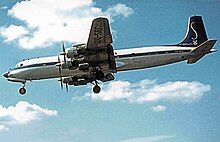 See alsoReferences
Further reading
External links
|
|||||||||||||||||||||||||||||||||||||||||||||||||||||||||||||||||||||||||||||||||||||||||||||||||||||||||||||||||||||||||||||||||||||||||||